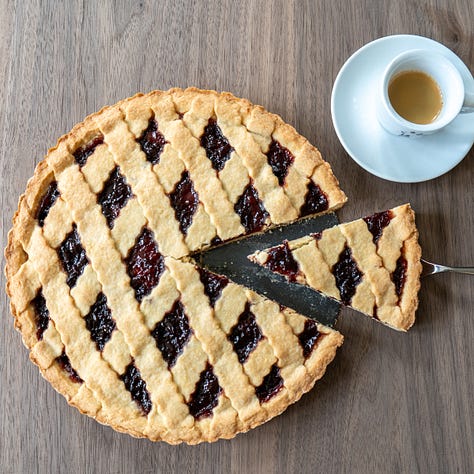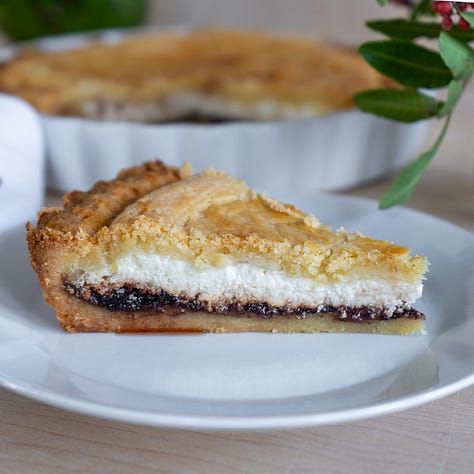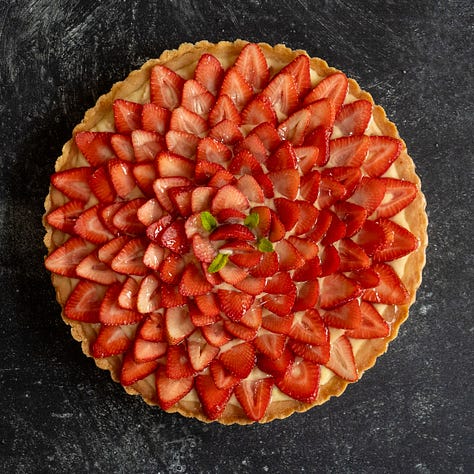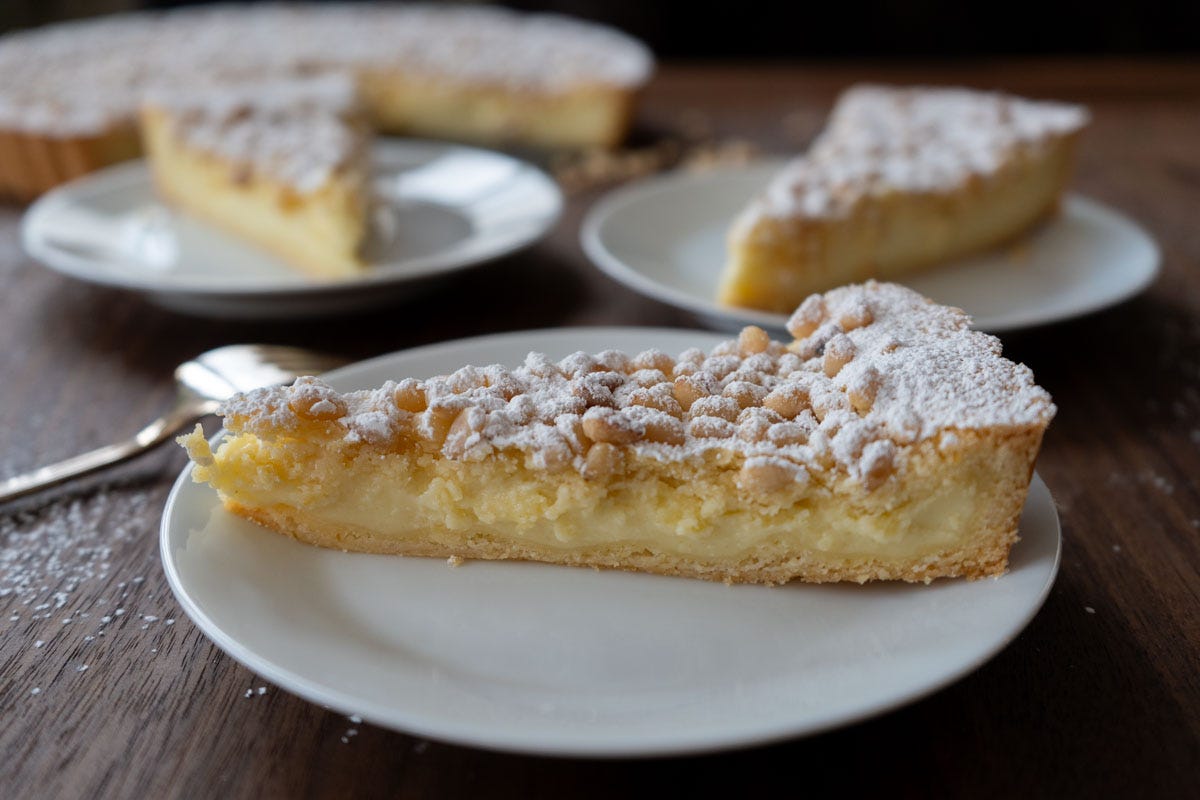Last week was quite a week. By the time the weekend arrived, I just wanted to stay home, listen to our Mina playlist on the little Bluetooth speaker in our kitchen, and bake something.
Why is baking so therapeutic?
It requires mindfulness to shut out distractions and follow a recipe. There’s something sensory and tactile about getting flour on your hands, cracking the eggs, and zesting the lemon. The buttery, toasty aroma wafting from a warm oven on a cold February day is comforting. Making something from scratch is satisfying, and sharing it with friends and family feels good. Whatever the reason, baking was the antidote to a weighty week.
I decided to make a torta della nonna, a classic Tuscan crostata-style dessert made with pasta frolla (a short pastry crust) filled with crema pasticcera (pastry cream) and topped with pine nuts and powdered sugar.
Nonna means “grandma” in Italian, and torta della nonna literally means “grandmother’s cake,” likely because it is a simple homemade treat, the type a grandmother would make to share with family.
I have an Italian cookbook of over 700 desserts, and it includes an entire section of Torte delle Nonne, the letter “e” turning the singular “grandmother’s cake” to the plural “grandmothers’ cakes,” implying that there is a whole category of nonna-style baked goods - unfussy, comforting, homemade desserts made with pantry staples.
The singular version, Torta della Nonna, always refers to the classic custard-filled shortcrust tart, usually topped with pine nuts. Apparently, the dessert did not actually originate in a grandmother’s kitchen. Instead, a Tuscan chef in Florence or Arezzo invented the recipe in the mid-20th century, naming it torta delle nonna to give it a nostalgic, homey feel.
There are a few variations of the recipe: Tradition calls for the custard cream to be layered between two sheets of pastry crust, one on the bottom and one on top. However, it’s common to find the custard cream filling left exposed, as well. While pine nuts are the most common topping, the pasticceria that supplies many of the bars and restaurants in our town of Montalcino uses sliced almonds instead.
Ingredients
1 tart
For the pasta frolla
300 grams Italian 00 flour or all-purpose flour
8 grams lievito Pane degli Angeli, or 3/4 teaspoon baking powder
150 grams sugar
175 grams butter
Zest of one lemon
For the pastry cream filling
3 egg yolks
100 grams sugar
3 cups whole milk
1/2 of a vanilla bean, or 1 tsp natural vanilla extract
3 heaping tablespoons flour
For the topping
100 grams of pine nuts
Powdered sugar
Kitchen tools
You can get by without any of these gadgets and bakeware, but having them will simplify things when making a torta della nonna.
Digital food scale that converts from pounds and ounces to kilograms and grams. In Italian recipes, ingredients are listed in grams. It’s so much easier and more precise than volume-based units of measure.
Zester. Lemon and orange zest are staples in Italian baking. If you don’t have one, a zester is a worthwhile addition to your repertoire of kitchen tools.
Tart pan with a removable bottom. You can make a crostata di frutta in any bakeware you like, but a 9” tart pan with fluted edges and a removable bottom is extra convenient and makes for a very pretty crostata.
Instructions
Prepare the pasta frolla
Add the flour, lievito Pane degli Angeli or baking powder, sugar, butter, egg yolks, and lemon zest to a mixing bowl.
Mix on medium speed with a stand mixer until the dough is combined.
Using a kitchen scale, divide the dough into two equal parts.
Shape each part into a ball, cover in plastic wrap, and refrigerate.
Prepare the crema pasticcera
Add the egg yolks and sugar to a small saucepan and stir until well-mixed.
Slowly add the milk to the eggs and sugar, stirring constantly until well mixed.
Add the seeds of half a vanilla bean or the vanilla extract, and place over low heat.
Using a tea strainer or sifter, slowly add the flour to the liquid, stirring vigorously with a wire whisk to incorporate all the flour.
Increase the heat to medium-lowVI O and stir the pastry cream continuously until it thickens and comes to a boil.
Remove the cream from heat, cover the surface of the cream with a piece of wax paper or parchment paper to keep a film from forming on top, and allow it to cool.
Assemble the torta
Preheat the oven to 350° F (180° C).
Prepare a 24 cm /9-10 in tart pan with butter and flour.
Place the pine nuts in a bowl of water.
Remove the pasta frolla from the refrigerator.
Sprinkle flour on a smooth surface and roll out one piece of dough until it is big enough to fill the base and sides of your tart pan.
Line the tart pan with the rolled-out dough, pressing it in so that it is equal in thickness on the bottom and on the sides. Trim any excess dough around the rim of the pan. Pierce the bottom of the crust a few times with a fork.
Pour the pastry cream on top of the crust and spread it smooth.
Roll out the second piece of dough until it is just larger than the tart pan.
Place the disk of dough on top of the crostata. Carefully pinch the top and bottom edges together to seal the crust. Make a few small cuts into the top of the crust.
Use a pastry brush to gently dampen the top of the crust with water.
Drain the pine nuts and sprinkle them on top of the crust.
Bake at 350° F (180° C) for approximately 40 minutes.
Let the crostata cool completely and use a tea strainer to dust it with powdered sugar before serving.
Notes
Italian 00 flour, such as Antimo Caputo Double Zero Flour, is ideal, but all-purpose flour will work fine.
Lievito Pane degli Angeli is an Italian leavening agent used in many Italian baked goods. Made of baking soda, baking powder, and vanilla aroma, you can substitute baking powder if you need to, but we buy a few boxes of Pane degli Angeli at a time and keep it on hand for our Italian baking.
You may also like…












This sounds absolutely delicious, Cara. I am so glad you had something comforting and soul filling to turn to last week. These weeks are very heavy, but finding beautiful people with whom I connect lightens the mood a bit. Some day I will have to try this recipe. Stay warm in the Minnesota tundra! Spring is coming!!!
This is one of my favorite Italian "soul" foods (aka breakfast). Simple and nurturing. For my husband Joe's Valentine's birthday, I made a different torta della nonna, one my grandma made (she called it "dopo scuola dolce"), a simple cake made with lemon zest and olive oil. But there's a birthday cake that you've made for Stefano, a recipe of his Mom's, that is light and sweet and a perfect dessert after a big meal. I seem to recall it can be made in a larger cake pan, to serve a crowd. Is this a recipe you'd share some day? Of course it's my goal to cook, bake, and remodel, ala Cara & Stefano.